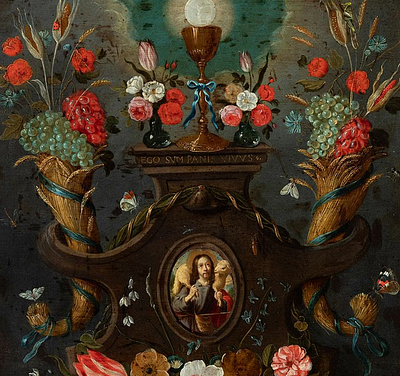Spanish school; early 17th century. "Infant Jesus triumphing over evil". Oil on canvas. Re-drawn.
Lot 35
About Seller
Setdart Auction House
Carrer Aragó 346
Barcelona
Spain
Setdart Subastas was born in 2004 and is currently the first online art auction in Spain with solidity, prestige and reliability guaranteed by our more than 60,000 users. Setdart has a young, dynamic and enterprising team ready to successfully manage the purchase and sale of art works through custom...Read more
Estimate:
EUR€4,000 - EUR€5,000
$4,210.53 - $5,263.16
Absentee vs Live bid
Two ways to bid:
- Leave a max absentee bid and the platform will bid on your behalf up to your maximum bid during the live auction.
- Bid live during the auction and your bids will be submitted real-time to the auctioneer.
Bid Increments
| Price | Bid Increment |
|---|---|
| EUR€0 | EUR€10 |
| EUR€200 | EUR€25 |
| EUR€500 | EUR€50 |
| EUR€1,000 | EUR€100 |
| EUR€3,000 | EUR€200 |
| EUR€5,000 | EUR€500 |
| EUR€10,000 | EUR€1,000 |
| EUR€20,000 | EUR€2,000 |
| EUR€50,000 | EUR€5,000 |
About Auction
By Setdart Auction House
Sep 21, 2021
Set Reminder
2021-09-21 10:00:00
2021-09-21 10:00:00
America/New_York
Bidsquare
Bidsquare : 21st September - ARAS JÁUREGUI Private Collection - Old Masters, 19th & 20th Century
https://www.bidsquare.com/auctions/setdart-auction-house/21st-september---aras-j-uregui-private-collection---old-masters-19th-20th-century-7429
Setdart Auction House sofia@setdart.com
Setdart Auction House sofia@setdart.com
- Lot Description
Spanish school; early 17th century. "Infant Jesus triumphing over evil". Oil on canvas. Re-drawn. It presents faults and restorations. Measurements: 86 x 61 cm. Devotional painting, where the artist has represented the Infant Jesus as the only protagonist of the scene. The figure of Christ is inscribed in an exterior dominated in its great majority by the light that emanates from the break of glory in the upper area. However, in the lower part of the canvas, the golden of the sky is counterbalanced by the cold tones of this area, which is defined by blues and greenish tones. Returning to the presence of the Child, it is worth noting his large dimensions, a characteristic which, together with his central position in the composition and the lack of large elements that distort the viewer's vision, offer a monumental view of the infant, thus eliminating his infantile aura and showing his suffering through symbolism, as for example with the use of the purple tunic, which attempts to reflect Christ's penitence. Alongside the Child, several iconographic attributes can be seen, firstly, a large blue ball, placed at the feet of Jesus, representing the world. This representation can be linked to the iconography of the Child of the Ball, which alludes to the universality of Christian doctrine, and consists of the representation of the Child Jesus with a sphere representing the universe, placed in his hand or under his feet. It is a Triumphant Child, Saviour of the World, and symbolises the idea of Jesus as man and saviour, lord of the whole Earth, which he redeems with his death and resurrection. It is an iconography that combines divine power and grace with the happy innocence and humble condition of God incarnate: the omnipotence of the Son. In addition, other elements can also be seen in the composition, such as the cross made of reeds, which is a representation of Christ's Calvary, and next to the ball, the serpent of original sin, with its corresponding apple in its mouth and the presence of an anthropomorphic being, in which a reptile's body is fused with a human face, thus exemplifying evil. The position of the Christ Child on these two iconographic representations shows the viewer a Child triumphant over evil, representing the concept of Christianity, in which virtue always triumphs over sin. Throughout its history, and especially in the Modern Age, Christian art delighted in casting the shadow of the cross over the innocent infancy of Jesus. The contrast between the happy unconcern of a child and the horror of the sacrifice to which he was predestined was designed to stir hearts. This idea was already familiar to the theologians of the Middle Ages, but the artists of the time expressed it discreetly. It was especially in the art of the Counter-Reformation that this funeral presentiment of the Passion was expressed by means of transparent allusions, as we see here.
- Shipping Info
-
In-house shipping available. Please inquire at admin@setdart.com.
-
- Buyer's Premium



 EUR
EUR CAD
CAD AUD
AUD GBP
GBP MXN
MXN HKD
HKD CNY
CNY MYR
MYR SEK
SEK SGD
SGD CHF
CHF THB
THB

















